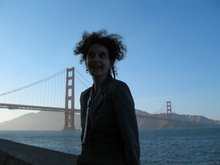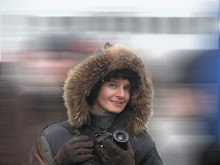Below is the interview reprinted in full with Thomas MacEntee of High Definition Genealogy and the founder of Geneabloggers.com. MacEntee is a genealogist specializing in the use of technology and social media to improve genealogical research and as a means of interacting with others in the family history community. Utilizing over 25 years of experience in the information technology field, MacEntee has organized and engaged a community of over 1,500 bloggers to document their own journeys in the search for ancestors.
Thomas MacEntee writes: "Recently I had the opportunity to review the products and services at Art For Your Sake here at
GeneaBloggers. Here is an interview with the creator and "artist in residence" at Art For Your Sake: Nancy Gershman - where we discuss Nancy's work and her interest in genealogy and family history."
Thomas MacEntee: The concept of “digital photomontage” as shown on your site – Art For Your Sake – is unique. How would you describe the concept to someone familiar with genealogy but unfamiliar with digital photomontage?
Nancy Gershman: As a legacy artist, I always begin research with a conversation. We’ll be looking at archival photographs, and either the front (or backs with handwritten notations) will launch all sorts of back stories about the person in the picture. Like the genealogist, I’m also seeking revelations and insights about my subject, but rather than focusing on ancestors, I’m ferreting out anecdotal data from the last people on earth to know this person (who in all likelihood may still be living, but who’s more likely deceased for one or two generations). I strive for some kind of balance between how my client wants to remember the subject, and how to honor the subject‘s own wishes about how they’d want to have been remembered. Deliverables are typically the transcripts of these wonderful conversations and a gestalt portrait, if you will, of the subject as remembered in the “family record.”
TM: Now, the digital aspect to my work opens up all sorts of transformative possibilities in terms of remembrance and continuing bonds with the deceased. Instead of being limited by a single photograph, I am able to combine multiple images from different photographs to tell a story about the “full person.” By manipulating everything from scale, light, shadow and color to mix and matching faces and limbs, landscapes, scenery, costumes and props, the viewer really begins to experience the personality, and even the belief systems of the subject.
NG: That might mean getting the best possible head shot from one photo and a body from another; placing the subject in a background that has significance for the viewer; placing meaningful objects around the subject; or having the subject engage with individuals who never existed in the original photo but who were very much “part of the story."
Journalist Patrick Butler got it right when he wrote that I “never expected to be telling stories created with the insight of a layout designer, stage director, choreographer– and more than the touch of a medicine woman.” It’s true.
TM: What types of family history-related gifts can be created using a photomontage?
NG: These are some of my favorite ideas of how clients used history in their photomontage gift:
• memorial portraits that have the deceased fulfilling a wish that was mentioned quite a bit to family members, but never consummated during their lifetime
• soulmate portraits, where a couple is surrounded by symbolic elements representing their decades-long love affair with each other – and with their individual passions
• honeymoon portraits, where a couple is taken to an exotic destination (back to their roots?) which they would never have been able to afford on their own
• spiritual portraits populated with meaningful objects celebrating that person’s moral, activist or religious character
• humorous portraits that roast the retiring exec, highlighting their achievements and social status, but also their peculiar interests and quirks from a historical perspective
Sometimes a client chooses not to frame their artwork, preferring to take it to the next level as photo purses (Bagettes.com); serving trays (www.designerphotogifts.com/Serving-Trays.html); tapestries (www.customcreationsunlimited.com) and 8×10 3-D “pop-outs” (http://www.photocutouts.com/).
Probably what I’m most excited about is a new product I’m working on: a coffee table “memory book” that in ten fine art photomontages restages epic events and family lore from one man’s life. You open the book to a beautifully illustrated timeline and family tree, followed by oral histories given by those who remember. From there the book flows into ten portraits falling across every key period of this person’s life.
TM: You also discuss the “healing” aspects of the photomontage medium on your site. Can you give an example?
NG: Any of my photomontages become “healing” when I prescriptively zero in on loss or regrets keeping an individual “stuck” in the past. In these instances – as the outsider – I help clients visualize a more positive and joyful narrative of what lies ahead by repurposing their photographs in a playful manner. The notion of play and truth-telling is enormously important here, not only because laughing (or the laughing cry) produces dopamine, but also because it’s the humor and irony in these visualizations that moves clients one baby step towards “completing their journey.” Often these “healing dreamscapes,” as I call them, are commissioned by concerned family or friends. For the more serious cases, I get additional input from a therapist, support group counselor or a member of the clergy.
One of my favorite examples is the dreamscape I made for a bereaved mother named Shirley. The part of her dreamscape that always soothed her right back to sleep was essentially two pleasing memories fused together as one. I cut out her 2-year old son from one photo, snuggled him onto Shirley’s lap, and then had the little guy warming his toes over the warmth coming up from a grill – the kind her son as a 30 year old used when grilling hot dogs out in the snow.
Readers might be interested in these articles about my healing photomontages about:
• a nurse who honors everyone who made a difference in her life: Positive Visualization: Photomontage helps individuals cope with grief by Rachel Christophe Baker (Advance for Nurses magazine) view online at Advance for Nurses Magazine.
• a bereaved dad coping with his loss: Campaigning for Craig: The Healing Power of a Legacy T-shirt view online at Hektoen International, A Journal of Medical Humanities.
• an anorexic newlywed reforming her husband: The Fisherman’s Lasagna: A Love Story about Prescriptive Photomontage and Anorexia view online at Hektoen International, A Journal of Medical Humanities.
TM: If someone approached you to construct a photomontage, how do you begin? How involved can they be in the creative process?
NG: I like my clients very involved in the creative process from the very beginning. I ask them to put their hands on candid photographs where they truly feel the true essence of the person coming through. I like them to gather really compelling stories for me, passed down through the family for which there may – or may not be – existing photographs. Once I start composing a rough of the photomontage, it gets emailed back and forth for comments. I’ll ask: What is superfluous? What is missing? By the first and second pass we’ve usually nailed it!
What probably is the most exciting thing about delivering the final photomontage is that frequently a client will see something in the artwork that’s completely unexpected: a secret message; a funny coincidence; some strange little anomaly which absolutely floors them. Like the widow who told me the place that gave her the greatest feeling of tranquility was Indian Boundary Park – and the photograph I chose for the background of her healing dreamscape turned out to be exactly the spot where she sprinkled her husband’s ashes!
TM: What led you to work in the digital art medium? Have you always been involved in the arts?
NG: I always loved cutting and pasting when journalling or making greeting cards for friends and family. As my friend Beth once said: “Layering – it’s how you weave things together in your own life”. The act is always relaxing for me, although my paternal grandmother and father were wonderful painters, preferring paintbrushes to a scissor. In college I was a theatre major studying playwriting, and later, I switched to communications and design, which became the gateway to work in advertising. Not surprisingly all these things melded together in my work as a photomontagist. Suspending disbelief and going for a strong conceptual composition comes in great part from my training in advertising. But I have to say that the confluence of Flickr (a photo-sharing website) and Photoshop (digital photo manipulation software) is what really allowed me to be able to do such custom work for my clients. Now I could search for location-specific photographs or artifacts, and basically reconstruct any historical scene a client pulls from memory. It’s pure theatre when you think about it.
TM: Have you always had an interest in family history?
NG: You could say I am completely fixated by other people’s “home movies”. It’s never been boring for me, ever, maybe because I use all sides of my brain. I look at snapshots and historical photographs like a curator of fine photography. When I listen to family stories, I’m asking questions and collecting ethnographic material like a cultural anthropologist. And when I’m editing someone’s oral history, I do it in Studs Terkel fashion, meaning I let the interviewee’s own words read like literature. Moving people to tears is the perfect job.
But there’s something else about why I am drawn to this field: I’m absolutely manic about making sure family history is never lost.
TM: Who is your favorite ancestor? What do you know about them?
NG: My favorite ancestor, Walter Bruce Schaffir, I’m afraid, is very much alive. He’s my Dad. At age 9, his father was driven mad by dental pain and apparently killed himself in Poland. As a teen, he was picked up by Viennese Nazis in a sweep of Jews after Kristallnacht, and then was miraculously released by a sympathetic desk sergeant. Over the age limit for a KinderTransport to Holland, he convinced the organizers to take him as a secretary so he could remain with his younger brother. Months later, after he got a visa to come to Cleveland, all the Jewish children in that Dutch camp were exterminated by the Nazis who invaded Holland. In the U.S., he worked days building coffins and cleaning machinery and went to school nights for his college degree. For the past two decades, macular degeneration propelled him to reinvent himself from painter to sculptor, and he plays drums in a jazz band at The Lighthouse twice a week. The guy is a maverick!
Thomas MacEntee:
"I have to say it is just amazing the types of connections you can make using social media outlets like Facebook and Twitter. A few months ago I found the site Art For Your Sake and connected with its owner Nancy Gershman on Twitter. Little did I know that she was just one neighborhood south of me here in Chicago! While we often think of making more long distance connections with social media, very often you can find folks in your own backyard!"
©2010, copyright Thomas MacEntee







